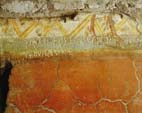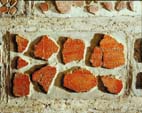 |
The Pontifical Council for the Laity,
in collaboration with the Meeting for Friendship Among Peoples, has
organized an exhibition dedicated to the apostles Peter and Paul for
the Jubilee Year, an initiative that promises to be one of the most
distinguished and pertinent, as its aim is to draw attention to the
origins of the very traditions onto which the meanings of the Jubilee
event historically were grafted.
The exhibition is divided into five sections.
The first, "The Judeo-Christian Community of Rome," displaying archaeological
finds, including lamps and inscriptions (almost all found in Rome),
illustrates the Jewish presence in Rome and serves mainly as a premise
for the exhibition.
The second, "The Cultural and Religious Climate," presents sarcophagi,
inscriptions, and some small objects that show aspects of popular
religion (albeit of high rank-we find here, among other things, some
engraved gems and silver plaques), briefly highlighting pagan religiosity
in Imperial Rome.
The third section, "The Story of the Two Apostles," delineates the
events in the life of the two founders of the community of Rome, using
funerary bas-reliefs (sarcophagi), devotional illustrations (papyrus
and ivory), and painted decorations (a copy of the ancient decorations
of the Church of Saint Paul outside the wall-San Paolo fuori le mura).
The fourth section, "The Iconography of Peter and Paul," uses statues,
vases, reliefs, sarcophagi, and especially gold glass to show how
the early Christians, not only in Rome, "saw" the two apostles.
The fifth section, "The Three Apostolic Basilicas and Veneration of
the Martyrs," essentially deals with written testimony, displaying
epigraphs in various forms-graffiti in the catacombs, inscriptions
on sarcophagi and stone plaques, engravings on metal, etc.
Invocations to the martyrs
Making pilgrimages to the places where the apostles rendered their
supreme witness and to their tombs has been perceived since the Church's
beginnings as a very special event. Pilgrimage is a way to live an
effective relationship with those who followed Christ most closely
and who, in Him, first of the risen, intercede with the Father during
the pilgrimage of every man through life and of history toward the
final goal.
Devotion of the two martyred apostles (and of all the martyrs) was
manifested essentially as a plea for intercession, which Christians
felt deeply as a protection to be requested from those who, having
given their life to announce the Good News, are in God's direct presence
and can work in favor of those who have accepted the risk of the Gospel.
Peter and Paul, remember Anthony; Peter and Paul, pray for Leontius÷:
thus read the graffiti (more
than 600 notes) scratched into the wall
of memory, in the Basilica Apostolorum-later dedicated to St. Sebastian-where
the crowds of pilgrims venerated Peter and Paul together from the
middle of the third century through the early decades of the fourth
century, before the Constantinian basilicas were built to honor Peter
in the Vatican and Paul along the Via Ostiense, the original sites
of their martyrdom and their tombs.
The inscription that Pope Damasus I (366-384) composed to be placed
in the Basilica Apostolorum celebrates the glory of the apostles Peter
and Paul, as they are with Christ in the reign of the just-ob meritum
sanguinis-because they shed their blood for Christ. And Rome boasts
of them because they were her citizens; in them she shines with a
new light to all the world.
Writings and places
In the familiar relationship with the apostles, the Christian people
seeks, preserves, and safeguards in Rome every sign of their presence
and keeps their memory alive by passing along traditi ons and episodes
that, on various levels of communication, express contents that are
simple yet complex, worked out by the people and assimilated in the
long itinerary traversed by the Church of Rome. These are writings
like the Acts of Peter; places like the Mamertine Prison; sacred spaces
like the Quo Vadis?; like the churches of San Pietro in Vincoli
(Saint Peter in Chains), San Paolo alle Tre Fontane (Saint Paul of
the Three Fountains), San Pietro in Montorio÷
Among all the aspects, however, the greatest highlight to the presence
of the apostles is the perception of the living continuity of Peter's
ministry through the apostolic succession. The mandate received by
Peter from the Risen Christ is present in history through his successor.
A homily delivered by Leo the Great on June 29, 443, comments on Peter's
profession of faith: "You are the Christ, the Son of the living God,"
and Jesus' reply which appoints Peter the cornerstone of the Church.
(Mt 16:16-17) This profession, says Leo, escapes the very bonds
of death. This is a voice that is the voice of life and has the power
to raise to heaven whoever offers it. For this reason St. Peter was
told, "I will give you the keys of the kingdom of heaven: whatever
you bind on earth will be bound in heaven; whatever you loose on earth
will be loosed in heaven." (Mt 16:19)
Without a doubt, Leo concludes, this power passed also to the other
apostles; however, there was a reason for entrusting just one with
what was communicated to all. In the person of the successor of Peter,
it is Peter himself who speaks and works and feeds the flock of the
only Lord.
In Rome, at the tomb of the martyrs, at the See of Peter, through
all the Church and through all the centuries, the itinerary of faith,
conversion, and forgiveness has continued.
Peter and Paul.
History, Veneration, Memory
Rome, Palazzo della Cancelleria
June 30-December 10, 2000

